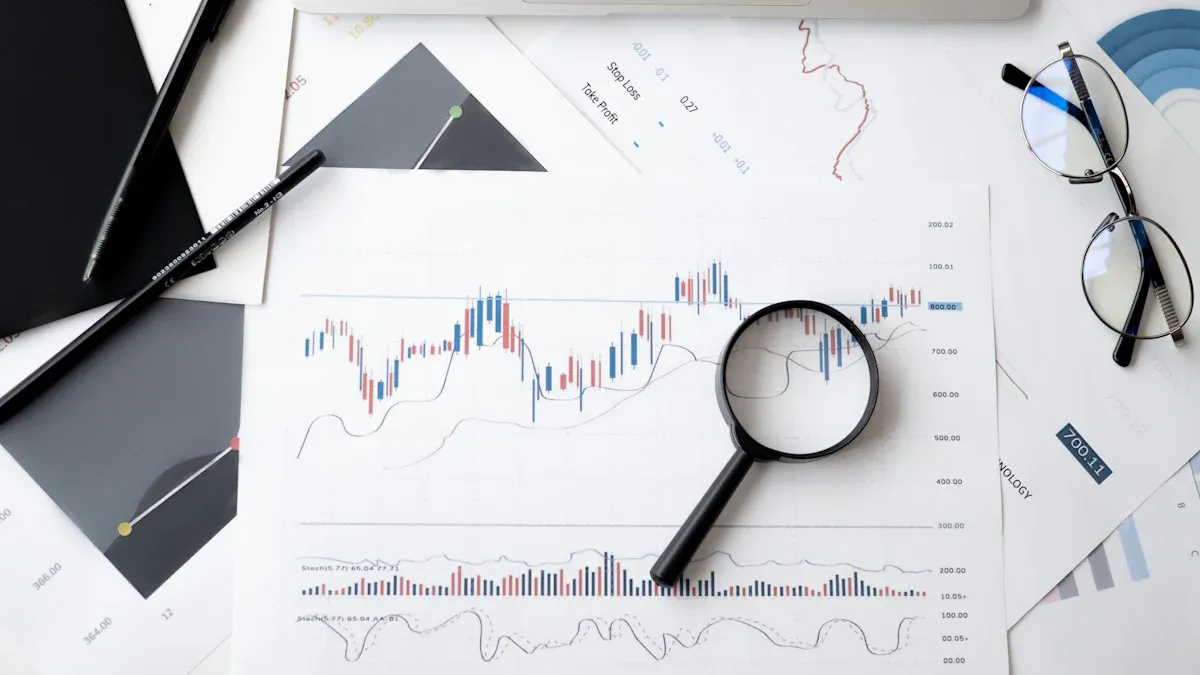- EasyCard
- Trade
- Help
- Announcement
- Academy
- SWIFT Code
- Iban Number
- Referral
- Customer Service
- Blog
- Creator
How Inflation Affects the Stock Market: A Comprehensive Analysis and Investment Strategy Recommendations

Image Source: pexels
You will find that the way inflation affects the stock market is very direct. Global inflation levels have risen synchronously in the post-COVID era, with wage increases forming a wage-price spiral. The U.S. market exhibits sticky inflation, with central banks frequently raising interest rates, and investors feel heightened market volatility. According to the latest statistics, stocks typically perform poorly during high inflation periods, and investors tend to prefer inflation-resistant assets like real estate. During periods of high volatility, psychological factors significantly influence investment decisions, and you need to closely monitor the impact of inflation changes on the market.
Key Points
- Inflation directly affects the stock market, and investors should focus on CPI data to gauge market inflation pressures.
- Corporate earnings are impacted by inflation, with companies that have strong pricing power better able to withstand inflationary pressures and maintain stable stock prices.
- During high inflation periods, asset allocation should be diversified, considering real assets like commodities and real estate to hedge risks.
- Sector performance varies, with energy and materials sectors typically performing well during inflation, making them suitable for investment.
- Pay attention to changes in monetary policy, as rising interest rates increase borrowing costs, affecting stock market performance, and investment strategies need timely adjustments.
Inflation and CPI

Image Source: unsplash
Definition of Inflation
You often hear the term “inflation” when investing. Inflation refers to the sustained increase in the overall price level of goods and services. You can think of it as your money buying fewer things. Economists analyze inflation in financial markets by focusing on its impact on economic growth and financial development. The following table can help you understand more intuitively:
| Initial Inflation Rate | Impact of Financial Development on Inflation Rate | Impact on Economic Growth |
|---|---|---|
| Low | Reduces | Promotes |
| High | Increases | Reduces |
You can see that low inflation contributes to economic growth, while high inflation may have negative effects. In the U.S. market during high inflation periods, corporate costs rise, consumer purchasing power declines, and investors tend to choose inflation-resistant assets.
CPI Indicator
When understanding inflation, you often encounter CPI (Consumer Price Index). CPI is one of the most commonly used indicators to measure inflation. You can observe changes in the prices of goods and services over time through CPI. The calculation method for CPI is scientific, with data sourced broadly.
- CPI is calculated based on data collected from thousands of retail and service institutions.
- CPI components can be broken down to better understand the contribution of each part to inflation.
- Reports analyzing the contribution of various components to CPI from 2019 to 2024 reveal the main drivers.
You can gauge the strength of market inflation pressures by monitoring CPI changes. CPI reports in the U.S. market are often a key reference for investors analyzing economic conditions. When making investment decisions, it’s advisable to regularly monitor CPI data to better grasp market trends.
Mechanisms of Inflation’s Impact on the Stock Market
Corporate Earnings Pressure
When analyzing how inflation affects the stock market, you should first focus on changes in corporate earnings. Inflation leads to rising costs for raw materials, labor, and transportation. If companies cannot pass on these cost increases to consumers, their profit margins will be squeezed. You can intuitively understand profit changes in different sectors during inflation through the table below:
| Industry | Profit Change |
|---|---|
| Oil and Gas Industry | Significant profit increase |
| Air Transportation Industry | Significantly affected by COVID |
| Other Industries | Profits maintain an upward trend |
You will find that the oil and gas industry typically achieves higher profits during inflation because they can smoothly raise product prices. The air transportation industry, however, faces dual pressures from the pandemic and costs, resulting in significant profit fluctuations. Other industries generally see rising profits, but the magnitude varies.
Many large international companies can easily raise prices during global inflation, thereby protecting or boosting profit margins. This phenomenon allows companies to maintain high prices even after supply chain issues ease, further increasing profits. You need to note that this leads to a decline in real household income, weakening consumer purchasing power, and ultimately affecting overall consumer demand.
- Large international companies can raise prices during global inflation, protecting or increasing profit margins.
- Even after supply chain issues are resolved, companies choose to raise profits rather than pass cost savings to consumers.
One key mechanism through which inflation affects the stock market is by influencing stock prices through changes in corporate earnings. When investing, you should focus on whether companies have pricing power and can maintain profitability in an inflationary environment. Companies with strong pricing power are more likely to withstand inflationary pressures, with relatively stable stock performance.
You also need to pay attention to inflation’s impact on consumer purchasing power. Inflation erodes the value of money, leading to reduced real wages and savings. Consumers need to spend more USD to buy the same goods, resulting in decreased purchasing power. The table below shows U.S. market stock performance during different inflation periods:
| Period | Inflation Rate | Cumulative Price Growth | Nominal Stock Market Growth | Real Stock Market Growth (Inflation-Adjusted) |
|---|---|---|---|---|
| 2016-2020 | 1.9% | 7.7% | 81% | 65% |
| 2021-Present | 4.9% | 19.6% | 39% | 15% |
You can see that, although nominal stock market growth appears strong, real returns significantly decline during high inflation periods. Another manifestation of inflation’s impact on the stock market is that investors are easily misled by nominal gains, overlooking the erosion of real returns.
Inflation significantly affects purchasing power, as it erodes the value of money, leading to reduced real wages and savings. When investing, you must ensure that the return rate exceeds the inflation rate, or your savings and investments will lose value.
Monetary Policy Linkage
When focusing on inflation’s impact on the stock market, you must also closely monitor changes in monetary policy. The U.S. central bank typically adjusts interest rates to address inflation. When inflation rises, the central bank often chooses to raise interest rates to curb economic overheating. Rate hikes increase borrowing costs for businesses and individuals, reducing market liquidity and putting pressure on the stock market.
The table below summarizes the short-term and long-term impacts of monetary policy changes on the stock market:
| Impact Type | Description |
|---|---|
| Short-Term Reaction | The stock market’s short-term performance largely depends on whether interest rate changes are anticipated. If rate changes are expected, the market typically remains relatively stable; if unexpected, it may lead to increased volatility and short-term declines. |
| Long-Term Reaction | In the long term, as interest rates fall, the stock market typically rebounds, as lower rates are seen as a catalyst for growth; conversely, when rates rise, the stock market may cool down. |
You can better understand the mechanism of inflation’s impact on the stock market through historical cases. For example, during 1979-1987, the U.S. central bank significantly raised interest rates, negatively affecting the stock market and leading to an economic recession. In 1981, the federal funds rate reached 20%, and unemployment rose, demonstrating the strong influence of monetary policy on the economy and stock market.
When investing, you should pay attention to the central bank’s policy signals. Rate hike cycles typically bring stock market volatility, and investor expectations adjust accordingly. The mechanism of inflation’s impact on the stock market is reflected not only in corporate earnings and consumer purchasing power but also profoundly affects monetary policy and market sentiment.
- When inflation rises, the central bank tends to raise interest rates to curb economic overheating.
- Interest rate changes affect corporate borrowing costs and investor risk appetite, thereby impacting stock market performance.
You need to comprehensively understand the mechanism of inflation’s impact on the stock market by considering corporate earnings, consumer purchasing power, and monetary policy. This will enable you to make more informed investment decisions in a complex market environment.
Impact on Performance
Short-Term vs. Long-Term
When observing inflation’s impact on the stock market, you should distinguish between short-term and long-term performance. In the short term, inflation often brings market volatility and changes in investor sentiment. You can understand the relationship between key influencing factors and the stock market through the table below:
| Influencing Factor | Relationship Type |
|---|---|
| Inflation and Stock Returns | Negative correlation |
| Market Volatility Caused by Inflation | Negative impact |
| Monetary Policy Uncertainty | Negative impact |
| Energy Sector | Positive correlation (hedging ability) |
You will find that when inflation rises, stock returns typically decline, and market volatility increases. Monetary policy uncertainty also makes investors cautious. The energy sector may serve as a hedge against inflation. In the long term, the market gradually absorbs the impact of inflation. Companies adjust their business strategies, and investors reallocate assets. You need to focus on the market’s adaptability and the recovery of corporate earnings.
Tip: When investing, be cautious of market volatility in the short term and focus on corporate fundamentals and industry trends in the long term.
Sector Divergence
Another key manifestation of inflation’s impact on the stock market is sector divergence. Different sectors have varying sensitivities to inflation. You can refer to the table below:
| Industry | Sensitivity Type |
|---|---|
| Energy | Positive sensitivity |
| Industrials | Positive sensitivity |
| Materials | Positive sensitivity |
| Real Estate | Positive sensitivity |
| Financials | Positive sensitivity |
| Communication Services | Negative sensitivity |
| Information Technology | Negative sensitivity |
You will find that energy, industrials, and materials sectors perform well during inflation because they can pass on cost increases through price hikes. Financials and real estate also have some inflation resistance. Communication services and information technology are more likely to be negatively affected, as these sectors rely heavily on capital costs and future earnings.
When investing, you can focus on sector rotation in the market. Typically, during rising inflation, the following sectors perform better:
- Energy and commodity stocks: Rising oil, gas, and metal prices drive related company performance.
- Consumer goods: Demand for essential goods like food and household products remains stable.
- Technology and growth stocks: These companies may face pressure due to rising borrowing costs.
You need to adjust sector allocation based on inflation cycles to seize investment opportunities from sector divergence.
Case Studies
Recent Data
When analyzing inflation’s impact on the stock market, you can first observe the performance of major U.S. stock indices under inflation pressures over the past five years. The table below shows the gains of the Dow Jones Industrial Average, S&P 500, Nasdaq Composite, and Russell 2000:
| Index Name | Point Gain | Percentage Gain |
|---|---|---|
| Dow Jones Industrial Average | 703.27 | 1.65% |
| S&P 500 | 107.00 | 1.83% |
| Nasdaq Composite | 466.84 | 2.45% |
| Russell 2000 | N/A | 1.99% |
You can see that, despite rising inflation levels, the stock market has maintained positive growth overall, but the gains are significantly below historical averages. The market experiences increased volatility during high inflation, and investors tend to prefer inflation-resistant assets. When investing, you should focus on the real returns of indices and avoid being misled by nominal gains.
Sector Case Study
When focusing on inflation’s impact on the stock market, the consumer goods sector is a typical case. Inflation pressure directly affects corporate earnings and stock prices. You can refer to the following points:
- Inflation is typically negatively correlated with consumer goods stock prices in the short term. You will find:
- Declining revenues and profits drag down stock prices.
- Economic slowdown creates an unfavorable macro environment.
- Tightening monetary policy and rising short-term interest rates prompt investors to shift to bonds.
- Expected real returns decrease, reducing demand for stocks.
- In the long term, companies may pass on costs to consumers by raising product prices. You will find that some companies’ revenues and profit margins gradually recover, supporting stock prices.
When investing in the consumer goods sector, you need to focus on companies’ pricing power and cost control. The mechanism of inflation’s impact on the stock market shows clear divergence at the sector level, with only adaptable companies maintaining competitiveness during inflation cycles.
Investment Strategy Suggestions

Image Source: pexels
Asset Allocation
When investing in an inflationary environment, asset allocation becomes particularly important. During high inflation periods, traditional stock and bond portfolios may not effectively hedge inflation risks. You can consider incorporating real assets into your portfolio, such as commodities, real estate, and infrastructure. These assets typically perform well during unexpected inflation, helping you hedge losses caused by inflation.
- Commodities and infrastructure have historically performed strongly during high inflation, diversifying stock risks.
- Holding a diversified real asset portfolio has lower volatility than holding a single asset class.
- Real estate and commodity assets provide better protection during inflation shocks.
You can reduce overall risk through diversified investments. Diversified portfolios perform better in inflationary environments because they reduce volatility. Consumer goods and healthcare sectors also perform steadily during inflation, providing additional stability to your portfolio. Concentrated investments may yield high returns under certain market conditions but are more vulnerable to significant losses during rapid inflation changes.
Tip: When allocating assets, combine real and traditional assets, dynamically adjust proportions, and ensure portfolio stability and profitability across different inflation cycles.
Sector Selection
When selecting investment sectors, you need to focus on which sectors perform well in an inflationary environment. Based on historical data, energy, materials, healthcare, and consumer goods sectors perform better during high inflation. The table below helps you intuitively understand the historical performance of various sectors:
| Sector | Historical Performance Description |
|---|---|
| Energy | Performs strongly during inflation, with an average annual return of 9%. Benefits significantly from rising oil prices. |
| Materials | Engages in inflation-sensitive commodities, performing well. |
| Healthcare | Provides inflation protection, driven by the pandemic and technological advancements. |
| Consumer Goods | Stable demand for essentials, limited price volatility, and reliable dividends. |
You can prioritize energy and materials sectors. Energy stocks generate the strongest real returns during unexpected inflation, with an average annual real return of 12.9%. Agricultural and industrial metals can achieve price increases during supply shocks, with industrial metals averaging a 30% real return at the end of economic cycles. Healthcare and consumer goods sectors provide stability and protection for your portfolio.
- The energy sector performs best during high inflation, benefiting from rising oil prices and geopolitical factors.
- The materials sector is closely tied to commodity prices, effectively hedging inflation risks.
- Healthcare and consumer goods sectors have stable demand, suitable for long-term holding.
When selecting sectors, you can dynamically adjust investment proportions based on market cycles and inflation expectations to seize opportunities from sector rotation.
Hedging Tools
When investing in an inflationary environment, using hedging tools appropriately can effectively reduce risks. Common hedging tools include the S&P 500 Index, real estate ETFs, Treasury Inflation-Protected Securities (TIPS), basic materials, energy sectors, and safe-haven assets like gold.
- Investing in the S&P 500 Index can diversify risks and provide stable long-term returns.
- Real estate ETFs perform strongly during inflation, hedging currency depreciation.
- TIPS protect their own cash flows but may not provide additional returns for the entire portfolio during high inflation.
- Gold performs strongly in certain inflation events, but its correlation with inflation has weakened since 1980, while broad commodities outperform gold in every inflation event.
The table below shows the performance of major hedging assets during inflation:
| Asset Class | Performance Description |
|---|---|
| Treasury Inflation-Protected Securities (TIPS) | Protects own cash flows but offers limited returns for the overall portfolio. |
| Gold | Appreciates in some inflation events but has unstable overall performance, with a 44% hit rate. |
| Broad Commodities | Outperforms gold during inflation, providing higher returns. |
You can flexibly choose hedging tools based on your risk appetite and investment goals. It’s advisable to regularly evaluate your portfolio structure and adjust it based on market changes to ensure asset preservation and growth in an inflationary environment.
Dynamic Strategy Adjustments
Adjustment Timing
When investing in an inflationary environment, choosing the right adjustment timing is crucial. You can assess whether to reallocate your portfolio by observing market and economic indicators. The following factors typically signal the need for strategy adjustments:
- Changes in consumer demand
- Commodity price fluctuations
- Central bank policy adjustments
- Interest rate changes
- Overall market performance
- Economic environment changes
Professional investors recommend regularly reviewing asset allocation and monitoring market trends and economic factors. You can evaluate the gap between your current portfolio and target allocation, understanding inflation’s impact on different asset classes. Maintain a disciplined rebalancing approach and avoid frequent “market timing” operations. When deciding to rebalance, consider deviations from your portfolio’s target weights and weigh the costs of adjustments.
Tip: During high inflation, stocks and commodities typically outperform bonds. You can increase the allocation of these assets based on market changes.
Macro Focus
When formulating investment strategies, you need to closely monitor macroeconomic variables. Inflation, monetary policy, GDP growth, and commodity prices all affect asset performance. You can refer to the table below to understand the impact of supply chain pressures on inflation and the stock market:
| Research Topic | Key Findings |
|---|---|
| Global Supply Chain Pressures and Inflation | Global supply chain pressures were a major driver of eurozone inflation in 2022, with lasting impacts. |
| Supply Chain Disruptions and Stock Market Impact | Supply chain disruptions not only affect company stock prices but also hinder their ability to access capital, damaging the market. |
You should focus on the following macroeconomic factors:
- Inflation rate
- Interest rate levels
- Economic growth rate
- Sector sensitivity to these factors
Supply chain disruptions lead to reduced manufacturing production, driving up inflation. During high inflation, you can choose companies with pricing power and stable demand, such as U.S. consumer goods companies, energy companies, and real estate investment trusts. You can also increase commodity investments through ETFs or commodity-related companies to provide inflation hedging for your portfolio.
It’s recommended to continuously monitor macroeconomic data and policy changes, adjusting your investment strategy promptly to enhance your portfolio’s risk resilience.
You now understand how inflation affects the stock market through corporate earnings, monetary policy, and sector divergence. You need to dynamically adjust your investment strategy and flexibly use various assets. The table below summarizes recent key economic indicators:
| Economic Indicator | Description |
|---|---|
| CPI Annual Growth Rate | 3.1%, inflation continues to rise |
| S&P 500 Performance | Hits record highs, market focuses on long-term growth |
You can manage your portfolio with the following strategies:
- Allocate stocks, international stocks, and TIPS
- Moderately hold gold and real estate
- Focus on commodities and floating-rate loans
You should continuously track economic and policy changes to enhance investment sensitivity.
FAQ
How should you adjust your portfolio when inflation rises?
You can increase the proportion of commodities, real estate, and energy assets. These assets perform better during inflation. Regularly check your portfolio to ensure returns exceed the inflation rate.
What market changes should you focus on after CPI data releases?
You can monitor fluctuations in major U.S. stock indices. When CPI rises, the market may experience short-term adjustments. Observe the performance of energy and consumer goods sectors and adjust your investment strategy promptly.
Why does inflation affect corporate earnings?
Inflation increases raw material and labor costs. If companies cannot raise product prices, profits decline. You can prioritize investing in companies with strong pricing power.
How do monetary policy changes affect the stock market?
U.S. central bank rate hikes increase borrowing costs and reduce market liquidity. You should monitor interest rate changes and adjust the allocation of stocks and bonds to reduce risks.
Which hedging tools are suitable for an inflationary environment?
You can choose broad commodities, real estate ETFs, and Treasury Inflation-Protected Securities (TIPS). These tools help hedge inflation risks and protect asset value.
he article thoroughly explained how inflation impacts your portfolio by eroding purchasing power and compressing real corporate earnings. To counter this risk, your core strategy is to hedge with real assets like commodities, energy, and real estate, and to strictly control transaction costs. However, high traditional remittance fees and trading costs often directly diminish the real returns gained from these inflation-proof assets.
You need a tool that minimizes cross-border fund management costs and provides highly efficient global trading access, ensuring that every dollar earned stays in your portfolio.
BiyaPay is dedicated to offering you a low-cost, high-efficiency global fund solution. We provide real-time exchange rate inquiry and conversion for fiat currencies, with remittance fees as low as 0.5%, helping you minimize capital loss. Our zero-commission contract limit orders perfectly suit your need for dynamic adjustments in high-volatility sectors like energy and materials during inflation cycles. BiyaPay supports seamless conversion between various fiat and cryptocurrencies, allowing you to access global markets, including Stocks, all on one platform with same-day fund arrival. Click the Real-time Exchange Rate Inquiry now and BiyaPay for quick registration, and deploy your global anti-inflation portfolio at the lowest cost!
*This article is provided for general information purposes and does not constitute legal, tax or other professional advice from BiyaPay or its subsidiaries and its affiliates, and it is not intended as a substitute for obtaining advice from a financial advisor or any other professional.
We make no representations, warranties or warranties, express or implied, as to the accuracy, completeness or timeliness of the contents of this publication.




Contact Us
Company and Team
BiyaPay Products
Customer Services
is a broker-dealer registered with the U.S. Securities and Exchange Commission (SEC) (No.: 802-127417), member of the Financial Industry Regulatory Authority (FINRA) (CRD: 325027), member of the Securities Investor Protection Corporation (SIPC), and regulated by FINRA and SEC.
registered with the US Financial Crimes Enforcement Network (FinCEN), as a Money Services Business (MSB), registration number: 31000218637349, and regulated by FinCEN.
registered as Financial Service Provider (FSP number: FSP1007221) in New Zealand, and is a member of the Financial Dispute Resolution Scheme, a New Zealand independent dispute resolution service provider.



















